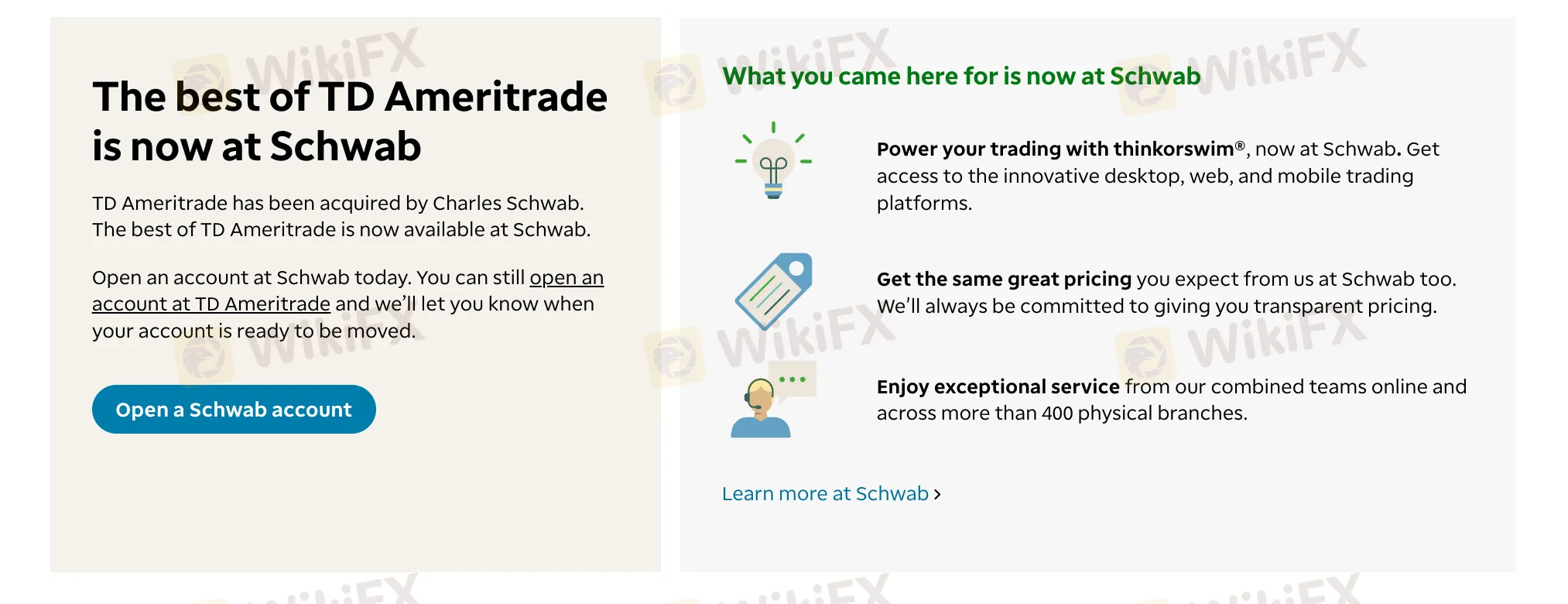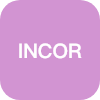Overview of thinkorswim
thinkorswim, founded in 2016 and based in the United States, offers a robust trading platform with a wide range of assets including stocks, ETFs, options, forex, futures, mutual funds, fixed income securities, and cryptocurrencies. Its user-friendly interface across desktop, mobile, and web platforms enhances accessibility.
However, its unregulated status exposes users to potential risks due to the absence of regulatory oversight. Despite this, thinkorswim's convenient deposit methods and responsive customer support contribute to its appeal among traders seeking a versatile trading experience.
Official website:https://www.tdameritrade.com/

Is thinkorswim legit or a scam?
thinkorswim operates without regulatory oversight, exposing users to potential risks. The absence of regulatory scrutiny means there are no established standards or safeguards, leaving traders vulnerable to fraudulent activities. Investors lack recourse mechanisms, and the platform lacks transparency and accountability.
The unregulated nature of thinkorswim heightens the likelihood of financial malpractices, making it imperative for users to consider alternative, regulated platforms for secure and transparent trading experiences.
Pros and Cons
Pros:
Wide range of trading assets: thinkorswim offers users access to a wide array of trading assets, including listed stocks, ETFs, options, forex, futures, mutual funds, fixed income securities, and cryptocurrencies.
User-friendly trading platform across devices: The thinkorswim platform is renowned for its user-friendly interface, offering seamless navigation and comprehensive trading tools across desktop, mobile, and web-based platforms. This accessibility ensures that users can monitor and manage their investments efficiently, regardless of their preferred device.
Various account types available: thinkorswim provides users with a range of account types to suit different investment strategies and goals. Whether users are planning for retirement, education, or seeking specialized account features, they can choose from individual brokerage accounts, retirement accounts (e.g., Traditional IRA, Roth IRA), education savings accounts (e.g., 529 Plan), specialty accounts, and margin trading accounts.
Convenient deposit methods: Funding a thinkorswim account is made convenient with multiple deposit methods available. Users can choose from electronic bank deposits (ACH), wire transfers, check deposits, asset transfers from other brokerage firms, and physical stock certificate deposits.
Responsive customer support: thinkorswim offers responsive customer support through various channels, including phone and email. Users can reach out to customer service representatives for assistance.
Cons:
Operates without regulatory oversight, potentially exposing users to risks: One significant drawback of thinkorswim is the absence of regulatory oversight, which can expose users to various risks.
Complex fee structures: While thinkorswim offers competitive trading fees for various types of trades, including listed stocks, options, and mutual funds, the fee structures can be complex and may vary depending on the type of trade and account type.
Market Instruments
The trading platform of thinkorswim provides access to a wide range of financial instruments, enabling users to build wide investment portfolios tailored to their preferences and objectives.
Listed Stocks and ETFs form a significant part of the platform's offerings, allowing users to trade shares of publicly listed companies and exchange-traded funds (ETFs) across various sectors and industries.
Additionally, the platform facilitates Options Trading, providing users with the opportunity to trade options contracts on equities, indices, and ETFs, allowing for enhanced flexibility and risk management strategies.
Users can also engage in Forex Trading, accessing the foreign exchange market to trade currency pairs and take advantage of fluctuations in global exchange rates.
Furthermore, thinkorswim supports Futures Trading, enabling users to trade futures contracts on commodities, indices, currencies, and more. This asset class offers opportunities for speculation and hedging against future price movements.
Additionally, the platform provides access to Mutual Funds through partnerships with leading fund providers, allowing users to invest in professionally managed portfolios covering various asset classes and investment strategies.
Moreover, users can trade Fixed Income Securities, including bonds and treasuries, to diversify their portfolios and generate steady income streams.
Lastly, thinkorswim offers Crypto Trading, allowing users to buy and sell cryptocurrencies such as Bitcoin and Ethereum, tapping into the growing digital asset market.
How to Open an Account?
You need to open a Schwab account to power thinkorswim: Visit the official website https://www.tdameritrade.com/interstitial.html
Click on “Open an Schwab Account”: Find the option to open a new account and click on it to begin.
Select Account Type: Choose the type of account you wish to open based on your investment goals and preferences. Schwab offers various account types, including individual brokerage accounts, retirement accounts (e.g., Traditional IRA, Roth IRA), education savings accounts (e.g., 529 Plan), and more. Click on the option that best suits your needs.
Complete Application: Fill out the online application form with accurate personal information, including your name, address, contact details, Social Security number (or other identification numbers), employment information, financial status, and investment objectives. Ensure all required fields are accurately filled to expedite the account opening process.
Fund Your Account: After completing the application, you will need to fund your Schwab account. Choose your preferred funding method, such as electronic funds transfer (EFT), wire transfer, or mailing a check. Follow the instructions provided to initiate the funding process.
Verify Identity: As part of the account opening process, Schwab may require you to verify your identity for security purposes. This typically involves providing additional documentation, such as a government-issued ID (e.g., driver's license, passport) and proof of address (e.g., utility bill, bank statement). Follow the instructions provided by Schwab to complete the identity verification process.

Leverage
The maximum leverage offered by thinkorswim is up to 50% for Margin Trading accounts. Margin trading allows users to borrow funds from the broker to increase their buying power beyond their cash balance, potentially amplifying their gains or losses.
Spreads & Commissions
The trading fees and commissions structure of thinkorswim offer competitive rates for various types of trades.
For listed stocks and ETFs, online trades incur no commission charges, providing cost-effective options for investors looking to trade these assets. Additionally, options trading carries an online base commission of $0, with an additional fee of $0.65 per contract. Mutual funds available through Schwab Mutual Fund OneSource can be traded online with no commission charges, offering investors access to thousands of funds without incurring additional fees.
Comparatively, for broker-assisted trades,listed stocks and ETFs incur a $25 service charge on top of the $0 commission.
Options trading through broker-assisted trades carries a fee of $0.65 per contract plus a $25 service charge. US Over-The-Counter (OTC) Equities trades incur a $6.95 fee for online trades, with an additional $25 service charge for broker-assisted trades.
These fees may influence the suitability of different account types for various user groups. For instance, investors who prefer self-directed trading and primarily trade listed stocks, ETFs, or options online may find the standard account most suitable due to its $0 commission structure for these trades. On the other hand, users who require broker assistance or frequently trade US OTC Equities may find the standard account less cost-effective due to the additional service charges associated with broker-assisted trades. Therefore, users should consider their trading preferences and frequency, as well as the associated fees, when selecting an account type on the thinkorswim platform.

Trading Platform
The trading platform of thinkorswim offers a range of options.
The desktop version is described as a fully customizable software providing access to various trading tools. It emphasizes the ability to test strategies, develop ideas, and execute trades, including complex ones. Users can tailor the platform to suit their trading styles and requirements.
For those preferring a mobile solution, the thinkorswim mobile app offers similar trading capabilities to the desktop version but optimized for smartphones. It provides access to trading features on-the-go, allowing users to stay connected to the market from their mobile devices.
Additionally, thinkorswim offers a web-based platform for streamlined trading. This version takes essential trading functionality from the desktop platform and presents it in a more intuitive interface accessible through a web browser. Users can access this platform from nearly any browser without the need for downloads.

Deposit & Withdrawal
Funding your thinkorswim account is made convenient with various payment methods available. One primary method is Electronic Bank Deposit (ACH), which allows users to electronically transfer funds from their bank account to their thinkorswim account. This method is popular due to its ease of use and quick processing time, typically completing within 5 minutes. The deposit limits for ACH transfers range from $50 to $250,000, providing flexibility for users with different funding needs.
Another option for funding your thinkorswim account is through Wire Transfer. This method offers a quick transfer of funds from your bank or other financial institution to your thinkorswim account, typically completing within 1 business day. Wire transfers have no set deposit limits, allowing users to transfer larger sums of money if needed. To initiate a wire transfer, users need to contact their bank and provide the necessary details for the transfer.
Users can also fund their thinkorswim account by sending a check for deposit. This method offers flexibility and is mobile-friendly, allowing users to use the mobile app or mail in a check for deposit into their thinkorswim account. The standard completion time for check deposits is typically 1-3 business days, and there are no set deposit limits, providing users with flexibility in funding their accounts.
Additionally, users have the option to transfer assets from another brokerage firm into their thinkorswim account. This can include stocks, options, ETFs, and other assets. The standard completion time for account transfers from another firm is about a week, and there are no set deposit limits, allowing users to transfer assets as needed.
For users holding physical stock certificates, there is an option to deposit these certificates into their thinkorswim account. This process typically completes within 1 business day, and there are no set deposit limits, allowing users to deposit physical stock certificates swiftly and securely.

Customer Support
Thinkorswim provides customer support through a dedicated contact number, 866 839 1100, ensuring direct assistance for inquiries and concerns. Additionally, users can reach out via email using support@thinkorswim.com. This multi-channel approach allows clients to choose the mode of communication that best suits their preferences. The contact number ensures prompt and real-time assistance, while email communication offers a written record for more detailed or complex queries.

Conclusion
In conclusion, thinkorswim presents a versatile trading platform with a broad range of market instruments and account types, serving various investment strategies and preferences. Its user-friendly interface across desktop, mobile, and web platforms enhances accessibility, allowing traders to stay connected to the market seamlessly.
However, the platform's unregulated status poses inherent risks, potentially exposing users to fraudulent activities and lacking established standards for investor protection. While thinkorswim offers competitive trading fees and convenient deposit methods, its complex fee structures and lack of regulatory oversight may deter some users seeking a more secure and transparent trading environment. Despite these drawbacks, the platform's responsive customer support and educational resources contribute to its appeal among traders looking for a comprehensive trading experience.
FAQs
Q: What types of assets can I trade on thinkorswim?
A: thinkorswim offers a wide range of assets including stocks, ETFs, options, forex, futures, mutual funds, fixed income securities, and cryptocurrencies.
Q: Is thinkorswim regulated?
A: No, thinkorswim operates without regulatory oversight, which means there are no established standards or safeguards for investors.
Q: What account types are available on thinkorswim?
A: Users can choose from standard, retirement (including Traditional IRA, Roth IRA, and Rollover IRA), education (including 529 Plans, Coverdell, and UGMA/UTMA), specialty, and margin trading accounts.
Q: How can I contact customer support?
A: You can reach thinkorswim's customer support team via phone or email for assistance with platform navigation, account-related inquiries, or technical issues.
Q: What deposit and withdrawal methods are available?
A: thinkorswim supports electronic bank deposits (ACH), wire transfers, check deposits, account transfers, and physical stock certificate deposits.































